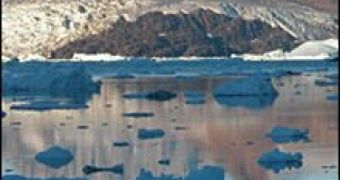A comprehensive analysis of satellite data collected between 1996 and 2005 has shown that the amount of ice Greenland lost has doubled in the last five years. Moreover, Greenland's glaciers have accelerated their slide into the Atlantic Ocean over the past decade and now their contribution to the global rise in sea levels is two to three times larger than previously estimated.
The Greenland ice sheet covers today an area of 1,7 million sq km and is up to 3km thick. However, scientists believe that Greenland might melt completely in several hundreds years which would account for a 7 meter global rise in sea levels. Researchers cannot give a very precise answer in this aspect. "It depends on how fast the glaciers can go and how sustainable the acceleration can be," said Dr Rignot of NASA's Jet Propulsion Laboratory in Pasadena, California. He added: "The behavior of the glaciers that dump ice into the sea is the most important aspect of understanding how an ice sheet will evolve in a changing climate. It takes a long time to build and melt an ice sheet, but glaciers can react quickly to temperature changes."
So, how fast is this "fast"? While Greenland was losing in 1996 about 100 cubic km of ice per year, this had increased in 2005 to about 220 cubic km. By comparison, a large city like Los Angeles uses only about one cubic km of water per year.
Rignot and his study co-author, Pannir Kanagaratnam of the University of Kansas, tracked the speeds of the glaciers from space, using the satellite data. The current observed acceleration seems to be caused by an increase in surface air temperatures. Over the past 20 years, the air temperature in south-east Greenland has risen by 3 degrees. What happens is that warmer temperatures increase the amount of melt water that reaches beneath the glaciers and lubricates their downhill flow over rock.
Rignot and Kanagaratnam predict that if warmer temperatures will spread to northern Greenland the glaciers there will pick up their pace too. Julian Dowdeswell of the University of Cambridge, who wrote an accompanying article, says that the only way to stop the loss of ice would be for Greenland to receive increased amounts of snowfall.
Photo credits: Kangerdlussuaq Glacier, East Greeland (J.A. Dowdeswell)

 14 DAY TRIAL //
14 DAY TRIAL //